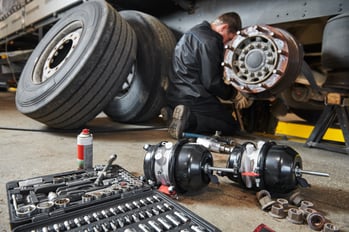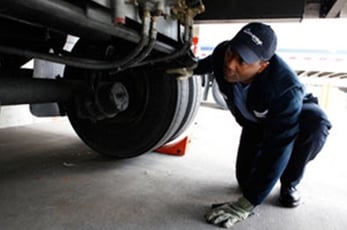 Are your brakes up to the challenge? Will they stop when you need them most?
Are your brakes up to the challenge? Will they stop when you need them most?
When considering the key components of a Commercial Motor Vehicle (CMV), brakes are at the forefront. While tires are important, even a CMV with severely worn-out tires can still move along the road. Brakes are crucial because, inevitably, there will come a time when you need to bring to a stop an 80,000-pound CMV, whether it's at a red light or in an emergency.
This year’s Brake Safety Week is scheduled for August 25-31 and is sponsored by the Commercial Vehicle Safety Alliance (CVSA) in partnership with the U.S. Department of Transportation’s Federal Motor Carrier Safety Administration (FMCSA). This annual campaign aims to elevate CMV brake safety and awareness throughout North America. During this time, CMV inspectors place a strong emphasis on conducting roadside brake system inspections, to identify any out-of-adjustment brakes and other violations.
Brake Safety Week is crucial because brake-related violations equate to the highest percentage of out-of-service vehicle violations found during these inspections. Improperly installed or maintained brake systems can reduce braking capacity and increase stopping distances, posing significant dangers to drivers and the public.
Last year's Brake Safety Week campaign highlighted brake systems and components. This year, the focus will be on brake linings and pads. On June 10, 2024, an unannounced one-day brake safety check took place in Canada, Mexico, and the United States. During that blitz, 4,898 CMVs were inspected, resulting in 570 vehicles being taken out of service. Of those vehicles, 185 were for lining and pad violations.
To prepare for the inspection, drivers must always perform both pre- and post-trip checks, carefully checking every visible aspect of the brake pads and linings. Maintenance teams should also be on the lookout for any missing linings, ensure proper drum clearance, and be cognizant of any signs of rust jacking, cracks, or voids in the lining.
Here are some tips on how to prepare ahead of the inspections:
For Drivers:

- Ensure thorough pre-trip and post-trip inspections by examining all visible portions of brake pads and linings.
- Check for bluing and crazing on brake drums and rotors, all indicators that they may need replacement.
- Look for signs of contamination such as hub oil or grease on the pad or shoe lining; if contamination is found, remove the unit from service immediately.
- Check the performance of the brakes by trying to move the tractor or trailer without releasing them; this is called performance-based testing. If the tractor or trailer moves at all, then the brakes have failed.
For the Maintenance department during PM inspections:
 Look for signs of missing linings, from rivets pushing through and scoring the drum.
Look for signs of missing linings, from rivets pushing through and scoring the drum.- Check the clearance on the drum or rotor, and ensure there is adequate lining on the brake shoe or pad.
- Inspect for signs of rust jacking, cracks, and visible voids in the lining.
- On disc brakes, heavily rusted rotors may indicate metal-to-metal contact between the caliper and rotor.
- Ensure any repairs follow manufacturers’ guidelines and recommended practices.
During the one-day brake safety blitz this year, nine locations utilized Performance-Based Brake Testers (PBBT). Four and a half percent of the tractors or trailers failed to meet the minimum 43.5% braking efficiency required and were placed out of service.
Addressing out-of-adjustment brakes and brake system violations is crucial, representing a significant portion of all out-of-service violations issued to CMVs. By ensuring proper installation, inspection, and maintenance of brake systems, you can enhance CMV safety and contribute to reducing the number of highway crashes.
For more information on Brake Safety Week: August 25-31, 2024 click here.


%20Cropped.jpg)



